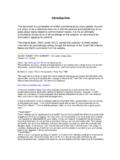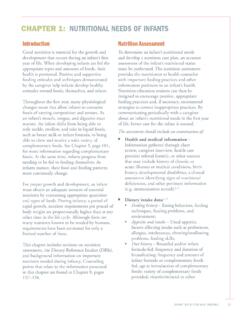Transcription of i1379e - Good Practices for the Feed Industry ...
1 ISSN 1810-1119. 9. FAO ANIMAL PRODUCTION AND HEALTH. manual GOOD Practices . FOR THE FEED Industry . Implementing the Codex Alimentarius Code of Practice on Good Animal feeding 9. FAO ANIMAL PRODUCTION AND HEALTH. manual GOOD Practices . FOR THE FEED Industry . Implementing the Codex Alimentarius Code of Practice on Good Animal feeding FOOD AND AGRICULTURE ORGANIZATION OF THE UNTIED NATIONS. FOOD AND AGRICULTURE. ANDORGANIZATION OF THE. INTERNATIONAL FEED UNITEDFEDERATION. Industry NATIONS. Rome, 2010. 2010. Recommended Citation FAO and IFIF. 2010. Good Practices for the feed Industry Implementing the Codex Alimentarius Code of Practice on Good Animal feeding .
2 FAO Animal Production and Health Manual No. 9. Rome. The designations employed and the presentation of material in this publication do not imply the expression of any opinion whatsoever on the part of the Food and Agriculture Organization of the United Nations, or of IFIF concerning the legal status of any country, territory, city or area or of its authorities, or concerning the delimitation of its frontiers or boundaries. The mention of specific companies or products of manufacturers, whether or not these have been patented, does not imply that these have been endorsed or recommended by FAO, or IFIF in preference to others of a similar nature that are not mentioned.
3 The views expressed herein are those of the authors and do not necessarily represent those of FAO, or the IFIF. ISBN 978-92-5-106487-0. All rights reserved. Reproduction and dissemination of material in this information product for educational or other non-commercial purposes are authorized without any prior written permission of the copyright. Applications for such permission should be addressed to the Chief Publishing Policy and Support Branch Office of Knowledge, Research and Extension FAO. Viale delle Terme di Caracalla 00153 Rome Italy or by e-mail to: FAO, 2010.
4 Iii Contents Foreword - FAO iv Foreword - IFIF v Introduction vii Glossary ix Feed Industry terms xii Feed ingredient terms xviii Abbreviations & Acronyms xix SECTION 1. Health hazards associated with animal feed 1 Section 2. General principles and requirements 7. Section 3. Good production Practices 19. Section 4. On-farm production and use of feed and feed ingredients 37. Section 5. Methods of sampling and analysis 51. Appendix I. The Codex Code of Practice for Good Animal feeding 59. Appendix II. National codes of practice 69. Appendix III. The role of national feed associations and setting up a feed association 73.
5 Iv Foreword FAO. Synergizing good Practices on animal feed Delgado et al. (1999) used the term Livestock Revolution' to describe the rapid growth of the global livestock sector in response to the increase in demand for food of animal origin which they said has profound implications for human health, livelihoods and the environment.. Livestock production is growing fastest in the developing world, particularly in Asia and Latin America. Increased output has been achieved mainly through the intensification of production sys- tems and through a shift towards poultry and pigs with much slower expansion of beef production.
6 Dairying too has increased in both scale and intensification. The industrialisation of livestock produc- tion systems, characterized by high animal densities and limited land base for the recycling of manure and other waste in crop agriculture, are associated with substantial environmental externalities and require particular attention to biosecurity, animal disease emergence and control as well as to animal welfare and domestic animal diversity management. Good Agricultural Practices (GAP) and good Practices in assessing , managing and communicating risks along the entire food chain are required.
7 Such Practices need to respect conditions of economic, environmental and social sustainability and to be geared towards protecting food safety and veteri- nary public health. FAO assigns high priority to the development of good agricultural and manage- ment Practices in livestock production and animal health; their application in the livestock sector relies on the active involvement of the sector itself in the design of such Practices . The close collaboration of Industry and inter-governmental agencies such as FAO in this endeavour is key for achieving the desired impact.
8 Food safety is a core area of the collaboration of all actors, private and public, for the protection of the animal product food chain from the farm to the consumer. Given the direct links between animal feed and the safety of foods of animal origin, it is essential that feed production and manufacture are considered as an integral part of the food production chain. Feed production must therefore be sub- ject, in the same way as food production, to the quality assurance of integrated food safety systems. The Joint FAO/WHO Codex Alimentarius Commission approved three important Codes affecting livestock production: the Code of Practice for Good Animal feeding , the Code of Hygienic Practice for Meat and the Code of Hygienic Practice for Milk and Milk Products.
9 FAO is determined to assist in the practical implementation of these Codes across the sector by bringing together the relevant actors in the animal feed and animal production, processing and retail chain to address the critical issues of food safety and sustainable development. The close collaboration between FAO and the sector's relevant players, such as the International Feed Industry Federation (IFIF) in the case of the design, production and introduction of this Manual of Good Practices for the Feed Industry is instrumental for achieving these important objectives.
10 Samuel Jutzi Director - Animal Production and Health Division Food and Agriculture Organization of the United Nations (FAO). Rome, Italy Delgado, C., Rosegrant, M., Steinfeld, H., Ehui, S. and Courbois C. 1999 Livestock to 2020: The Next Food Revolution. International Food Policy Research Institute, Food, Agriculture,and the Environment Discussion Paper No. 28, 72 pp. v Foreword IFIF. Our industries should embrace this worthy endeavour For the first time ever, the feed Industry has developed an international Feed Manual that focuses on the issues of feed and food safety.












